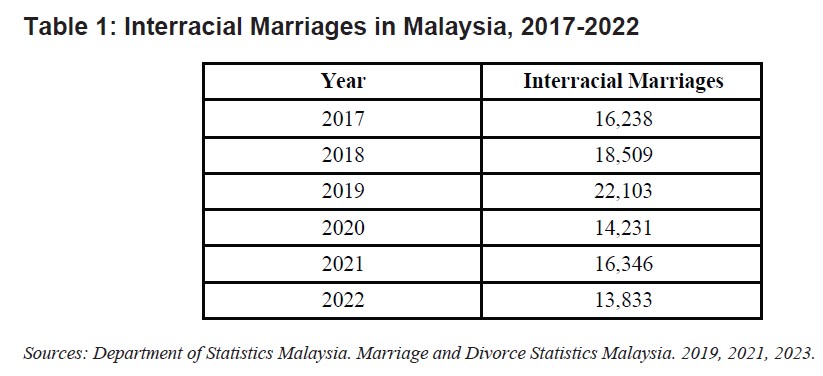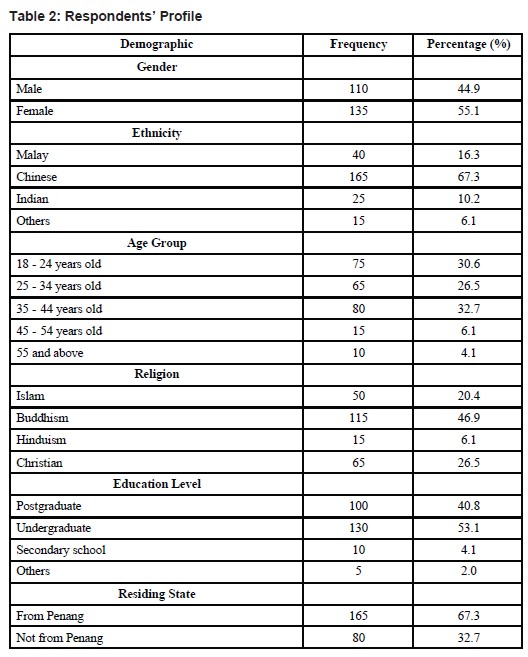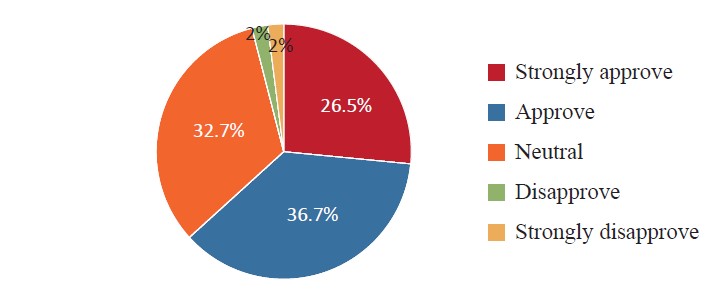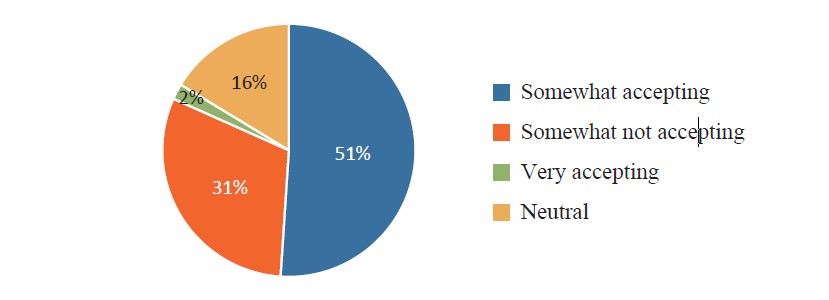
Executive Summary
transformation in ethnic relations within Malaysian society.
The findings of a Penang Institute survey on interracial marriages indicate widespread
approval among respondents from all racial backgrounds, with consistent support across
generations.
questions: religious conversion, family acceptance and social expectations, cultural
adaptation, and communication issues.
interracial marriages is to simplify legal complexities related to family law, which is often
religion-based. Couples face administrative challenges with multiple legal systems, and they
expect the government to ease the process.
become crucial. Aspects related to religious, financial, and civil rights need to be managed
in order to establish a supportive environment for such couples.
accurately reflect societal changes, acknowledge the complexity of individuals’ identities,
enable better policy research, and promote social equity by providing detailed demographic
data to illustrate trends in interracial marriages and their socio-economic impacts.
Introduction
In Malaysia, interracial marriages used to be stigmatized and viewed by negative perceptions. However, the statistically proven trend today is that such marriages are on the rise. In 1974, the rate was only 0.5%. It was estimated to be 4.5% from 1991 to 2000. In recent years, the rate seems to have risen even more. In 2017, the Department of Statistics Malaysia’s Marriage and Divorce Statistics report showed that interracial marriages accounted for 8%, or 16,238, of the 203,741 registered marriages. In 2018, this figure increased to 9%, with 18,509 out of 206,253 marriages being interracial. It further rose to 11% in 2019, with 22,103 out of 203,821 marriages being interracial. The rate dropped in 2021 and 2022, but still recorded 16,346 and 13,833 interracial marriages respectively (Table 1). This upward trend reveals tendencies towards social cohesion which could mean profound transformations for ethnic relations in Malaysian society.
This paper analyzes the evolution of perceptions on interracial marriages in Malaysia, and the
implications of the abovementioned trend, and concludes with some policy recommendations. A
survey on understanding interracial marriages in Malaysia was conducted by Penang Institute to
examine current trends and identify major characteristics in those trends.
Table 1: Interracial Marriages in Malaysia, 2017-2022

The Changing Perception on Interracial Marriages
In Malaysian studies, interracial marriages remain understudied. Only a handful of studies have
explored the topic, and these are mainly of two major types. The first are analyses of basic social
demographic characteristics in these marriages. The second are bolder, and examine the challenges
faced by interracially married couples in Malaysia.
The first type of interracial marriage studies uses basic demographic data as background information. They provide recorded data on the ethnicity of couples, education level, occupation, religion, age, income group, and location. In a pioneering study, Sanusi (1981) investigated interracial marriages in Melaka and discovered that these marriages were found across major ethnic groups, mostly between Indians and Malays, followed by those between Chinese and Malays. A study by Nagaraj (2009: 75) referred to the 2000 Population Census and discovered that interracial ‘marriage rates wre higher inethnically more diverse East Malaysia than in Peninsular Malaysia.’ Tan et al. (2008) comprehensively examined the socio-demographic characteristics of interracial marriage in Malaysia with a sample size of 357 couples through questionnaires. They concluded that the marriages in the study tended to be inter-religious, and they tended to involve couples with similar social characteristics. Tey (2021: 122) found that ‘intermarriage rates tend to be higher for the more diversepopulation, the minority, and the better educated.’
The second type of interracial marriage studies retells the challenges and concerns of such couples. A study based on a sample size of 50 couples reinforced the discourse of rigid ethnic lines to be a challenge in the lives of these people (Pue & Nidzam Sulaiman 2013). Furthermore, it also found that intervention from family members was a major challenge; this apparently often stemmed from the typical negative racial stereotypes promoted in mainstream society. The marriages also faced legislative and bureaucratic dilemmas (ibid. 274 & 275). In the most recent study, by Foong & Teoh (2022), the predominant challenge identified was the requirement for non-Muslims to convert to Islam for the marriage.
In summary, existing studies of interracial marriage lack scope and are trapped by the presumption that ethnicity is the main difficulty. With the rise in interracial marriages, Malaysian society may be experiencing a transformation that goes deeper than generally assumed. There are more aspects to be explored, such as the changing identity of the married couples, the children’s racial identity, and implications of the marriage on nation building. Further research can enhance understanding of interracial marriages and reflect on how this cross-ethnic group can potentially challenge Malaysian society’s ethno-religious fixations.
Survey on Understanding Interracial Marriages
A survey on understanding interracial marriages was conducted from 1 December 2023, to 31 May 2024, to collect data on public acceptance of such marriages, using a random sampling method. The survey comprised a total of 13 questions: 9 multiple-choice and 4 open-ended, taking approximately 15 to 20 minutes to complete. A total of 245 respondents participated. Basic demographic information of the respondents is presented in Table 2. The majority of respondents were Chinese and Buddhists with higher education background. In terms of gender, the distribution was even.

Findings and Discussions
Survey Highlights
There are four main findings from the survey.
1. Approval of interracial marriages is high.
Only 4% select ‘disapprove’ or ‘strongly disapprove’ on interracial marriages. As many as 63.2% of respondents choose ‘strongly approve’ or ‘approve,’ while 32.7% remain neutral (Figure 1). Overall, there is minimal negative view on interracial marriages. However, since nearly one-third of respondents returning a neutral answer, this substantial uncertainty should not be ignored.
Figure 1: Personal opinion on interracial marriages

2. Perceived societal acceptance lags behind individual approval of interracial marriages.
When asked about how accepting Malaysian society is of interracial marriages, 30.6% believes Malaysian society is somewhat not accepting of these. The perceived societal acceptance rate may be in the majority, at 53%, but this is lower compared to their own assumption on individual acceptance of interracial marriages. There seems to be a disconnect between personal attitude and perceived societal acceptance. Additionally, 16.3% of respondents are neutral. Although most respondents individually approve of interracial marriages, they believe that society still has strong reservations on the matter (Figure 2).
Figure 2: How accepting is Malaysian society of interracial marriages?

3. Approval of interracial marriages comes from all races.
When data by ethnic group are tabulated, it becomes clear Malaysians are nearly unanimous in their approval of interracial marriages. There is no significant variation across ethnic groups in the approval of interracial marriages.
4. Approval of interracial marriages comes from all age groups.
When tabulating the data by age groups, no generational differences in views on interracial marriages appear. The assumption that the younger generation is more likely to approve of interracial marriages compared to older generations is not supported. Interracial marriages are accepted by all generations.
In summary, the approval of interracial marriages is high, with only 4% strongly disapproved or disapproved according to the findings. This aligns with another recent study conducted mainly with Malay respondents, which also showed a high approval rate as high as 87.2% in favor of interracial marriages (Erie Nur Fatihah Nor Hafizam et al., 2023). The survey’s sample size comprised 81.4% Malay and only 9.1% Chinese respondents. This complements the current survey, which has a sample size of 67.3% Chinese and 16.3% Malay respondents (see Table 2). Interestingly, in this survey, respondents personally accept interracial marriages but perceive their fellow Malaysians as somewhat less accepting than themselves. This can be explained by the challenges highlighted by respondents in the open-ended questions.
Challenges
Regarding their views on challenges faced by couples in interracial marriages, respondents highlight four main areas in open-ended questions. These are: the religious conversion issue; family acceptance alongside social expectation; adaptation to cultural differences; and the communication issue.
1. The religious conversion issue
The religious conversion issue is one of the main concerns raised by respondents. A respondent explains that ‘I am a Malay Muslim and my partner is a Punjabi Sikh. The positive side is we got so much to learn and explore about each other and our respective culture and religion. The most negative side of all is getting approval from both families. Because of the different religions, we can’t get married unless he converts to Islam, [hence], we can’t live together or even spend intimate time together’.
Another respondent clarifies that ‘In Malaysia, interracial marriages are diverse due to the country’s multicultural population. While the constitution recognizes the freedom to practice any religion, there are legal complexities related to family law, which are often based on the individual’s religion. Couples may face administrative challenges in dealing with multiple legal systems’. Hence, a respondent suggests laws be passed ‘that safeguard interracial marriage and
[couples’] rights.’
2. Family acceptance alongside social expectation
Similar to interracial marriages in other countries, family acceptance and social expectation are major issues. A respondent states that ‘sometimes things like weddings are held differently across cultures and there are different expectations from both families so you got to find a middle ground to satisfy all parties including parents and relatives of both bride and groom. Thankfully for me, language is not so much of a barrier as me and my husband’s family can speak each other’s language. Other challenges I face until today are stares and attention from strangers when we are in public. It can get a bit intimidating for a person like me who prefers privacy.’ Another respondent is positive on this matter, saying ‘I believe that interracial relationships bring a wonderful opportunity to learn from and embrace diverse cultures. While I’m open to the richness that comes with such connections, I also recognize that there can be challenges. Navigating cultural differences, societal expectations, and family dynamics may require open communication, patience, and a commitment to understanding each other. I believe that unconditional love and mutual respect can overcome these hurdles, and the journey of building a life together is worth the effort.’
3. Adaptation to cultural differences
The challenge of cultural differences is another aspect to overcome. A respondent elucidates that ‘[I] started well but as we got along, [I] realized the hurdles and challenges and mutually decided not to take things further. The good thing is we get to know each other’s cultures and this brings an understanding towards the other culture. However, the main hurdle is acceptance, and also religion. This can be big challenges for both of us.’
At the same time, the interracial relation can be fruitful as explained by this respondent: ‘As a Malay, [I have] been in a relationship with a Chinese boy. The relationship opened my eyes to many new things and helped me gain a better understanding of both of our cultures/beliefs.’
4. The communication issue
The communication issue is a challenge that is mainly between family members from different sides. A respondent highlights communicating with the in-laws to be challenging. ‘I know basic Hokkien but my girlfriend’s mom speaks Hakka’.
The Role of Government
Regarding the role of government in supporting interracial marriages, a major suggestion relates to ‘legal complexities related to family law, which is often based on the individual’s religion’. The ‘couples may face administrative challenges in dealing with multiple legal systems’. Hence, they expect the government to ‘ease the process’. Other suggestions include to ‘offer family support services’ and ‘have laws that safeguard interracial marriage’. One respondent optimistically observes that ‘despite complexities, many interracial marriages thrive, reflecting Malaysia’s rich cultural tapestry. Open dialogue, cultural understanding, and legal reforms can further support the harmonious coexistence of diverse family in Malaysia’.
Limitation of the Survey
The sample in the study predominantly consists of individuals from the middle class with a tertiary education background. Therefore, the findings represent a population segment from the higher education group. The respondents are also mostly from Penang, which is historically a melting pot and which tends to exhibit an open-minded perspective on the subject. In terms of age, respondents are mainly from the young to middle-age groups.
Recommendations
With the number of interracial marriages increasing, it is important to deliberate policies that can encourage this positive trend in order to foster a more inclusive society and, by addressing religious, financial, and civil right aspects, to create a supportive environment for the couples. The trend can be further promoted through social awareness programmes.
1) New category of ethnicity in census
As interracial marriages become more common, it is important for the census to reflect these changes. This helps in updating societal narratives and ensuring that demographic data remain relevant and accurate. Individuals from interracial marriages often have complex, multifaceted identities that are most probably not accurately captured by existing categories. A new category can better reflect the diverse and evolving nature of the population. Detailed demographic data enable researchers to study trends in interracial marriages and follow their social and economic
impacts. This can provide insights into integration, assimilation, and social cohesion. In summary, creating a new category for ethnic groups resulting from interracial marriages in the census can lead to more accurate representation, better policy making, informed research, and greater social equity.
2) Inclusive family policies
Guarantee equal rights and protection for interracial families. Develop family policies that recognize and support the diversity of families, particularly in legal frameworks related to family rights, inheritance, and child custody. This is to ensure fairness and social justice regardless of religion.
3) Celebrities and social media influencers endorsement
Public awareness campaigns through engagement of celebrities and social media influencers can be used to challenge stereotypes of interracial marriages.
Conclusion
In primary school textbooks, the story of Princess Han Li-Poh marrying Sultan Mansor Shah of Melaka used to be a grand narrative for introducing interracial relations, although its historical accuracy has recently been questioned. The notion of interracial marriages was once unpopular among certain ethnic groups due to the strong racial contestations found in Malaysian society. However, with increased social interaction in various social settings, individuals from different ethnic backgrounds have become more receptive to such relationships. Han Li-Poh and Sultan Mansor Shah are now’ spiritually’ reflected in the statistics showing the rise of interracial marriages. To further encourage integration, a token of reward, or support, could be given to interracial couples to sweeten the deal and promote the trend.
References
1. Department of Statistics Malaysia 2019. Marriage and Divorce Statistics Malaysia 2019. Putrajaya:
Department of Statistics Malaysia.
2.___________________________ 2021. Marriage and Divorce Statistics Malaysia 2021. Putrajaya:
Department of Statistics Malaysia.
3.___________________________ 2023. Marriage and Divorce Statistics Malaysia 2023. Putrajaya:
Department of Statistics Malaysia.
4.Erie Nur Fatihah Nor Hafizam et al. 2023. ‘The Level of Acceptance towards Interracial Marriage Among Malaysian’. The 10th International Islamic Economic System Conference, Faculty of Economics and Muamalat, Universiti Sains Islam Malaysia, 14 August 2023, https://oarep.usim.edu.my/jspui/bitstream/123456789/21883/1/The%20Level%20of%20Acceptance%20Towards%20Interracial%20Marriage%20Among%20Malaysian.pdf (accessed 9 April 2024).
5.Foong, Andrew L.S. & Teoh, Eliza J.Y. 2022. “Multiethnic Intergenerational Perspectives on
Interethnic Marriages in Peninsular Malaysia: The challenge of ethno-religionist identity”. International Social Science Journal, 72(244): 403-422.
6.Nagaraj, S. 2009. “Intermarriage in Malaysia”. Malaysian Journal of Economic Studies, 46(1), 75-92. Pue, Giok Hun & Nidzam Sulaiman. 2013. “‘Choose One!’: Challenges of Inter-Ethnic Marriages in Malaysia”. Asian Social Science, 9(17): 269-278.
7.Sanusi, D. 1981. “Perkahwinan antara etnik: Satu kajian di bandar Melaka”. Akademika, 19: 76-83.
8.Tan, Jo-Pei et al. 2008. “Socio-Demographic Characteristics of Intercultural Marriage: A Study of a Multi-Ethnic Community in Malaysia”. European Journal of Social Sciences, 5(4): 30 – 44.
8.Tey, Nay Peng 2021. “The Changing Spousal Differentials in Socio-demographic Characteristics in Malaysia”. Institutions and Economics, 13(4): 121-151.
You might also like:
![Chinese Property Projects in Southern Johor: Should We Be Concerned?]()
Chinese Property Projects in Southern Johor: Should We Be Concerned?
![Tracking Malaysia’s Development Expenditure in Federal Budgets from 2004 to 2018]()
Tracking Malaysia’s Development Expenditure in Federal Budgets from 2004 to 2018
![Reducing Moral Hazards in Malaysia’s Public Healthcare System]()
Reducing Moral Hazards in Malaysia’s Public Healthcare System
![EU-Malaysia Trade Ties Strengthen despite Persistent Differences]()
EU-Malaysia Trade Ties Strengthen despite Persistent Differences
![A Review of Malaysia’s Progressive Wage Policy White Paper]()
A Review of Malaysia’s Progressive Wage Policy White Paper






